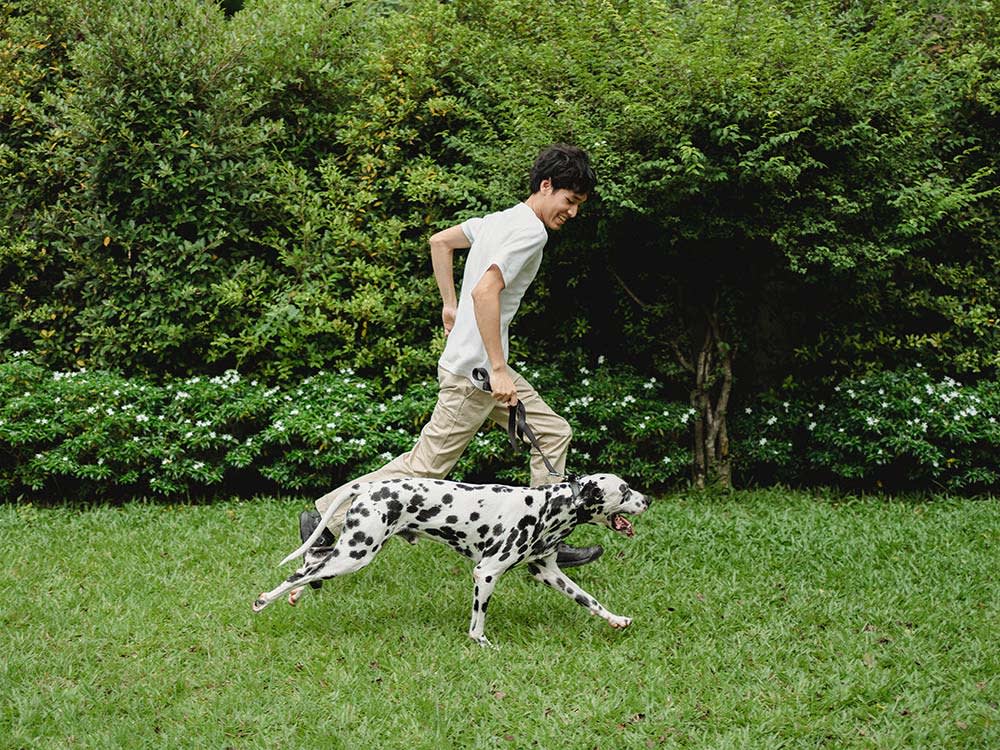An Active Dog Is a Well-Behaved Dog
Why regular exercise can mean a less destructive dog and a happier you.

share article

Your pet wants you to read our newsletter. (Then give them a treat.)
Changing any behavior takes time, patience, and dedication. When dogs are feeling mischievous, anxiousopens in a new tab, or stressed, they can cause a lot of damage — chewing shoes, counter surfingopens in a new tab, scratching, barkingopens in a new tab — the list of undesirable behaviors goes on. Animal shelters are filled with pets abandonedopens in a new tab because people don’t realize the time and dedication required to train good manners. While there is rarely a quick fix for anything, regular exercise can provide a huge benefit. Even with well-trained dogs, exercise matters if you want good behavior.
What should you do about destructive dog behaviors?
Training obviously helps with problem behaviors, but it’s not the only way to avoid trouble. Dog trainers have long valued the role of exercise in minimizing destructive dog behaviors such as barkingopens in a new tab, chewing, jumpingopens in a new tab around, being unable to settle down or sleep well, digging, whining, and relentless attention-seeking. Studiesopens in a new tab show that more exercise was correlated with lower levels of fear, less aggressionopens in a new tab toward familiar dogs, and reduced excitability.
In one study, a group of dogs was divided in half; one half worked on formal training while the other half had their exercise increased to two 30-to-45-minute sessions a day. After six weeks, the dogs who had additional training showed improvements in both their responsiveness to cues and their problem behaviors. The dogs who had extra exercise also exhibited problem behaviors less frequently, although their responsiveness to cues had not improved. So, how does exercise affect behavior through physiological means?
How does exercise improve dog behaviors?
Like people, dogs can achieve an emotional state described as a “runner’s high,” which may be why your pup is so excited for the chance to go out on a run. It may also be why so many people believe the old saying, “A tired dog is a good dog.” But these well-behaved and well-exercised dogs may be more influenced by chemistry than by fatigue.
A runner’s high is caused by chemicals called endocannabinoids, which signal the reward centers of the brain. Endocannabinoids lessen both pain and anxiety as well as create feelings of well-being. Running triggers higher levels of these compounds, which is why running makes people (and dogs) feel good.
If you’re laughing at the thought and can’t imagine putting yourself through the misery of running on purpose, you aren’t alone. While most dogs are excited about runningopens in a new tab, humans, on the other hand — outside of a small percentage — aren’t interested. Still, the potential to activate the chemicals that cause a runner’s high exists within you — even if you aren’t dipping into it as frequently as your long-ago ancestors, for whom running long distances was part of daily life.
This pleasurable, rewarding quirk of chemistry is not universal among mammals. In a studyopens in a new tab investigating the phenomenon of the “runner’s high,” researchers predicted that running would result in pleasurable chemical reactions in species with a history of endurance running. They studied three types of mammals — humans, dogs, and ferrets — and found that the two with distance running in their evolutionary pasts (humans and dogs) exhibited elevated levels of one particular endocannabinoid (anandamide) after running on a treadmill. Ferrets, non-cursorial animals, had no such chemical response and derived no pleasure from it. (Now you might be wondering if you’re part ferret.)
A happy dog is a good dog.
The behavioral benefits of running may be related more to contentment than fatigue. Perhaps, what we call “tired” is actually better described as “happy,” “relieved of anxiety and pain,” and “experiencing feelings of well-being.” If so, exercise may indirectly benefit dogs’ behavior because it elevates moodopens in a new tab rather than simply makes them too worn out to misbehave. Since endocannabinoids lessen the anxiety that can be a source of problem behaviors, it’s easy to see how exercise could help.
Running is also associated with the production of other chemicals that reduce anxiety in mammalian brains. Researchers reportedopens in a new tab that mice given the opportunity to run handled stress and anxiety better than sedentary mice. The study observed the brain activity in both groups of mice and found that runners had more excitable neurons in the ventral hippocampus — which plays a role in anxiety — than sedentary mice.
The active mice, however, also had more cells capable of producing the calming chemicals that inhibit activity in that area of the brain, which lessens anxietyopens in a new tab. The study supports the idea that for mice, at least, running improves the regulation of anxiety through inhibitory activity in the brain. It is possible that the situation is similar in dogs, though without studying them specifically, we can’t know for sure.
What does this mean for your dog?
Of course, behavior and physiology, and the links between the two, are never completely straightforward. There is evidence that cannabinoids can cause hyperactivity at low doses, even though they have calming effects at higher doses.
Age, breed, and individual differences play a role in the amount of exercise requiredopens in a new tab to keep your dog’s halo on straight and prevent them from sprouting little horns, behaviorally speaking. Some dogs thrive on small amounts of exercise. For others, the same amount of exercise — perhaps a leash walk at a leisurely pace — has the opposite effect. It invigorates them and may actually induce hyperactivity. For example, for a dog that typically runs 60 to 70 miles a week, switching to shorter exercise sessions for one week (say during a vacation) might actually just amp them up.
Your dog will also experience different effects from various amounts and types of exercise (running, hikingopens in a new tab, swimmingopens in a new tab, playing tugopens in a new tab, or fetch). When looking at ways to help reduce your dog’s destructive behaviors, you’ll need to find the right balance of training and exercise to help ensure that your pup is content.
Besides the well-known physical benefits of exercise, its psychological and behavioral benefits are profound. Stopping annoying behaviors and increasing good behaviors make the beautiful relationship between people and dogs that much better. What more could you want for your dog than the highest quality of life, minimal anxiety, the most elevated feelings of contentedness, and the best possible relationship with you?

Karen B. London, PhD, CAAB, CPDT-KA
Karen B. London, Ph.D., is a Certified Applied Animal Behaviorist and Certified Professional Dog Trainer who specializes in working with dogs with serious behavioral issues, including aggression, and has also trained other animals including cats, birds, snakes, and insects. She writes the animal column for the Arizona Daily Sun and is an Adjunct Professor in the Department of Biological Sciences at Northern Arizona University. She is the author of six books about training and behavior, including her most recent, Treat Everyone Like a Dog: How a Dog Trainer’s World View Can Improve Your Lifeopens in a new tab.
Related articles
![A woman with curly black hair playing with her white labradoodle dog outside]() opens in a new tab
opens in a new tab7 Games That Can Actually Teach Your Dog Something
Cue the Schoolhouse Rock! because learning can be fun.
- opens in a new tab
“Can My Dog Be Trained Not to Dig?”
Stop your dog from digging up your favorite plants with expert advice from animal behaviorist Karen London, PhD.
![Trendy woman in a green coat walking her cute dog in a white jacket in public]() opens in a new tab
opens in a new tab6 Reasons to Set Boundaries for Your Dog
Well-trained dogs have more freedom (and more fun).
![Old Great Dane dog sitting in grass and looking up at the hand of his owner during a training sessions]() opens in a new tab
opens in a new tabAre You Making These Common Dog Training Mistakes?
Pro Karen London, PhD shares the most common dog training errors and how to correct them.
![Three dogs on leashes meeting and sniffing each other on a walk on the summer grass with owners]()
How Do I Get My Shy Dog To Socialize?
The Wildest Collective dog trainer Robert Haussmann’s tips for getting a shy pup to go from wallflower to social butterfly.









